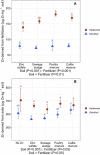The Use of Stable Zinc Isotope Soil Labeling to Assess the Contribution of Complex Organic Fertilizers to the Zinc Nutrition of Ryegrass
- PMID: 34992617
- PMCID: PMC8724203
- DOI: 10.3389/fpls.2021.730679
The Use of Stable Zinc Isotope Soil Labeling to Assess the Contribution of Complex Organic Fertilizers to the Zinc Nutrition of Ryegrass
Abstract
Manure and sewage sludge are known to add significant amounts of zinc (Zn) and other metals to soils. However, there is a paucity of information on the fate of Zn that derives from complex organic fertilizers in soil-plant systems and the contribution of these fertilizers to the Zn nutrition of crops. To answer these questions, we grew Italian ryegrass in the presence of ZnSO4, sewage sludge, and cattle and poultry manure in an acidic soil from Heitenried, Switzerland, and an alkaline soil from Strickhof, Switzerland, where the isotopically exchangeable Zn had been labeled with 67Zn. This allowed us to calculate the fraction of Zn in the shoots that was derived from fertilizer, soil, and seed over 4 successive cuts. In addition, we measured the 67Zn:66Zn isotope ratio with the diffusive gradients in thin films technique (DGT) on soils labeled with 67Zn and incubated with the same fertilizers. After 48 days of growth, the largest fraction of Zn in the ryegrass shoots was derived from the soil (79-88%), followed by the Zn-containing fertilizer (11-20%); the least (<2.3%) came from the seed. Only a minor fraction of the Zn applied with the fertilizer was transferred to the shoots (4.7-12%), which indicates that most of the freshly added Zn remained in the soil after one crop cycle and may thereby contribute to a residual Zn pool in the soil. The 67Zn:66Zn isotope ratios in the DGT extracts and the shoots measured at cut 4 were identical, suggesting that the DGT and plant took up Zn from the same pool. The proportion of Zn derived from the fertilizers in the DGT extracts was also identical to that measured in ryegrass shoots at cut 4. In conclusion, this work shows that stable Zn isotope labeling of the soil available Zn can be used to precisely quantify the impact of complex organic fertilizers on the Zn nutrition of crops. It also demonstrates that DGT extractions on labeled soils could be used to estimate the contribution of Zn fertilizers to plant nutrition.
Keywords: DGT (diffusive gradients in thin films); manure; plant nutrition; sewage sludge; source tracing.
Copyright © 2021 Yan, Dürr-Auster, Frossard and Wiggenhauser.
Conflict of interest statement
The authors declare that the research was conducted in the absence of any commercial or financial relationships that could be construed as a potential conflict of interest.
Figures



References
-
- Amer F., Rezk A. I., Khalid H. M. (1980). Fertilizer zinc efficiency in flooded calcareous soils. Soil Sci. Soc. Am. J. 44, 1025–1030. 10.2136/sssaj1980.03615995004400050031x - DOI
-
- Berenguer P., Cela S., Santiveri F., Boixadera J., Lloveras J. (2008). Copper and zinc soil accumulation and plant concentration in irrigated maize fertilized with liquid swine manure. Agron. J. 100, 1056–1061. 10.2134/agronj2007.0321 - DOI
LinkOut - more resources
Full Text Sources

